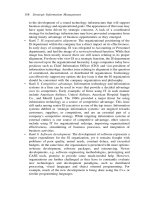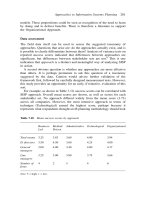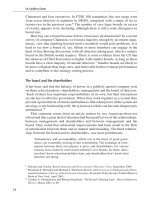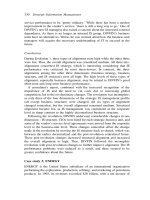Management extra LEADERSHIP AND MANAGEMENT IN ORGANISATIONS
Bạn đang xem bản rút gọn của tài liệu. Xem và tải ngay bản đầy đủ của tài liệu tại đây (2.55 MB, 119 trang )
Management Extra
LEADERSHIP AND
MANAGEMENT IN
ORGANISATIONS
This page intentionally left blank
Management Extra
LEADERSHIP AND
MANAGEMENT IN
ORGANISATIONS
AMSTERDAM L BOSTON L HEIDELBERG L LONDON L NEW YORK L OXFORD L PARIS L
SAN DIEGO L SAN FRANCISCO L SINGAPORE L SYDNEY L TOKYO
Pergamon Flexible Learning is an imprint of Elsevier
Linacre House, Jordan Hill, Oxford OX2 8DP, UK
30 Corporate Drive, Suite 400, Burlington, MA 01803, USA
First edition 2007
Copyright © 2007 Elearn Limited. All rights reserved
No part of this publication may be reproduced, stored in a retrieval system
or transmitted in any form or by any means electronic, mechanical,
photocopying, recording or otherwise without the prior written permission
of the publisher
Permissions may be sought directly from Elsevier's Science & Technology
Rights Department in Oxford, UK: phone (+44) (0) 1865 843830;
fax (+44) (0) 1865 853333; email: Alternatively
you can submit your request online by visiting the Elsevier web site at
and selecting Obtaining permission to
use Elsevier material
Notice
No responsibility is assumed by the publisher for any injury and/or
damage to persons or property as a matter of products liability, negligence
or otherwise, or from any use or operation of any methods, products,
instructions or ideas contained in the material herein.
British Library Cataloguing in Publication Data
A catalogue record for this book is available from the British Library
Library of Congress Cataloging-in-Publication Data
A catalog record for this book is available from the Library of Congress
ISBN: 978-0-08-046528-9
For information on all Pergamon Flexible Learning publications visit
our web site at books.elsevier.com
Printed and bound in Italy
07 08 09 10 11 10 9 8 7 6 5 4 3 2 1
Contents
List of activities
List of figures
vii
viii
List of tables
ix
Series preface
xi
Introduction: Management and leadership in organisations
xiii
1 Essentials of leadership and management
1
What is the relationship between management and leadership?
1
Developing as a leader
10
Models of leadership
15
Recap
20
More @
22
2 The organisational setting
23
Organisations – structure and culture in balance
24
Organisational structures – from hierarchies to network
organisations
32
What kind of organisational culture do you have?
41
Managing subcultures
47
Recap
50
More @
51
3 Influence and relationships
52
Emotionally intelligent leadership
60
Behavioural styles
64
Beliefs and behaviours
70
Recap
74
More @
75
4 Developing a high performance culture
76
The conditions for empowerment
77
Crafting vision and meaning
81
How participative is your leadership style?
88
Coaching, questioning and feedback
94
Recap
100
More @
101
References
103
This page intentionally left blank
Activities
Activity 1
The roles of the managerial leader
7
Activity 2
Reflection as a learning technique
14
Activity 3
Approaches to leadership
18
Activity 4
Organisational congruence
30
Activity 5
An unusual workplace
38
Activity 6
The culture in your organisation
46
Activity 7
Working across cultural boundaries
49
Activity 8
Building the power of your network
57
Activity 9
Your emotional competence
62
Activity 10 Framing your message
69
Activity 11 Surfacing your beliefs
73
Activity 12 Your approach to empowerment
79
Activity 13 Vision, stakeholders and commitment
86
Activity 14 Your leadership style
92
Activity 15 Developing a coaching culture
98
Figures
1.1 Management and leadership as roles
3
1.2 The Competing Values Framework
5
1.3 The spiral of experience
12
1.4 Determinants of behaviour
12
1.5 Perspectives on leadership
15
1.6 Influences on leadership
17
2.1 Organisational chart
25
2.2 Vertical complexity
25
2.3 The organisational iceberg
26
2.4 Organisational congruence
28
2.5 Organisational congruence at Wildings
31
2.6 The functional organisation
33
2.7 The divisional organisation
34
2.8 The matrix organisation
35
2.9 Schein’s three levels of culture
42
3.1 Paradigms of influencing
53
3.2 Sources of power
54
3.3 The emotional intelligence framework
62
3.4 Conflicting perspectives
65
3.5 Beliefs, behaviours and results
70
3.6 The ladder of inference
71
3.7 Short circuiting reality
72
4.1 The empowered mindset
78
4.2 Vision and alignment
81
4.4 Stakeholder mapping
87
4.5 The leadership continuum
89
4.6 Follower readiness
90
4.7 The coaching cycle
95
Tables
1.1 Managers and leaders (Bennis,1989)
2
1.2 Leadership roles and competencies from the competing
values framework
6
1.3 Critical incident analysis
13
1.4 Serving the needs of followers
18
1.5 Models of leadership
21
2.1 Grouping by division
33
2.2 Benefits and considerations of a matrix structure
35
2.3 Organisational purpose and structure
37
2.4 Culture types
48
3.1 Ten tactics for influencing
55
3.2 A framework for emotional competence (ei.haygroup.com)
61
4.1 The nature of empowerment
78
This page intentionally left blank
Series preface
Series preface
Whether you are a tutor/trainer or studying management
development to further your career, Management Extra provides
an exciting and flexible resource helping you to achieve your goals.
The series is completely new and up-to-date, and has been written
to harmonise with the 2004 national occupational standards
in management and leadership. It has also been mapped to
management qualifications, including the Institute of Leadership
& Management’s middle and senior management qualifications at
Levels 5 and 7 respectively on the revised national framework.
For learners, coping with all the pressures of today’s world,
Management Extra offers you the flexibility to study at your own
pace to fit around your professional and other commitments.
Suddenly, you don’t need a PC or to attend classes at a specific time
– choose when and where to study to suit yourself! And, you will
always have the complete workbook as a quick reference just when
you need it.
For tutors/trainers, Management Extra provides an invaluable guide
to what needs to be covered, and in what depth. It also allows
learners who miss occasional sessions to ‘catch up’ by dipping into
the series.
This series provides unrivalled support for all those involved in
management development at middle and senior levels.
Reviews of Management Extra
I have utilised the Management Extra series for a number of Institute
of Leadership and Management (ILM) Diploma in Management
programmes. The series provides course tutors with the flexibility to
run programmes in a variety of formats, from fully facilitated, using
a choice of the titles as supporting information, to a tutorial based
programme, where the complete series is provided for home study.
These options also give course participants the flexibility to study in
a manner which suits their personal circumstances. The content is
interesting, thought provoking and up-to-date, and, as such, I would
highly recommend the use of this series to suit a variety of individual
and business needs.
Martin Davies BSc(Hons) MEd CEngMIMechE MCIPD FITOL FInstLM
Senior Lecturer, University of Wolverhampton Business School
At last, the complete set of books that make it all so clear and easy to
follow for tutor and student. A must for all those taking middle/senior
management training seriously.
Michael Crothers, ILM National Manager
xi
This page intentionally left blank
Introduction
Management and leadership
in organisations
John Kotter of the Harvard Business School is one of a number
of experts who believe that organisations are over managed and
under led, at least partially because people do not appreciate the
differences between management and leadership.
We start this book by asking you to challenge your mental models
of leadership and management. In the literature, models for
leadership and management are evolving all the time, yet mostly we
base our thinking about what does or doesn’t work on our personal
experience. The consequence is that it is easy to become trapped
in a particular style and way of working, and to rely on the same
strategies to get us through very different situations.
Agility has become a prerequisite for organisations in a business
environment that is characterised by change. The implications for
management and leadership have been profound. Two trends in
particular have been evident.
First hierarchical systems of management are yielding to a ‘new
leadership’ movement which has at its core shared vision and
individual empowerment in place of consistency and control.
Second, leadership is no longer the preserve of those in positions
in the management hierarchy. Increasingly it is dispersed
through the organisation. There are now many who have a
responsibility for leading and managing in some form.
By developing your awareness of these and other influential trends,
you will be better equipped to flex your style and to play the
diverse roles required of the managerial leader in contemporary
organisations. In this book you explore the changing nature of
organisations and assess what this means for the leadership role.
Your objectives are to:
♦ use contemporary concepts and theories to analyse your
approach to management and leadership and to identify
areas for development
♦ review how organisational structures are changing to enable
organisations to become more agile and responsive to their
stakeholders
♦ evaluate the culture of your organisation and team and assess
what this means for effective management practice
xiii
♦ improve your influencing skills and the level of influence you
hold with organisational stakeholders
♦ explore ways in which you can build a culture of
commitment, performance and learning.
1 Essentials of leadership and management
1
Essentials of leadership and
management
As a concept leadership has been around for thousands of years. In
contrast, management science, driven by the phenomenon of large
organisations and the need to bring order and consistency to their
functioning, only emerged during the 20th century.
Leadership is different from management, but not for the reasons
most people think. Leadership isn’t mystical and mysterious.
It is not necessarily to do with being exceptionally brilliant or
charismatic. It is not the province of a chosen few. Nor is leadership
better than management or a replacement for it. Without good
management, complex enterprises tend to become chaotic in ways
that threaten their very existence.
In this theme, you will:
♦ explore the relationship between leadership and management
in contemporary organisations
♦ identify the diverse roles of the modern manager and explore
your strengths and preferences
♦ explore why leaders need to be self-aware and practice
techniques to develop self-awareness.
What is the relationship between
management and leadership?
Recently there has been a surge of interest in leadership and it has
been driven by a number of factors:
♦ The information age has had a profound effect on the workings
of organisations. Information and knowledge are now readily
available to all of us who bother to seek it out. Successful
managers are no longer characterised by what they know but
how they create a culture that enables people to achieve their
true potential.
♦ Globalisation has resulted in diversity in its widest sense.
To maximise contribution, managers are now challenged
with creating inclusive working environments. They need to
understand cultural perceptions of leadership and to deploy
a wide variety of leadership styles to build trust and effective
working relationships.
♦ Organisations have become flatter reducing the number of
managers and increasing their span of control. People on the
front line now have greater responsibility for decision making
Leadership and Management in Organisations
and directing their own activities. With greater empowerment
comes the need for strong values and a shared vision to help
people make the right choices.
♦ Rapid economic and technological change in the external
environment poses new opportunities and threats to the
organisation and therefore to the leaders in organisations. How
can they handle such turbulence and steer the organisation to
success?
As organisations have struggled to meet these challenges, there has
been growing recognition that management science, with its focus
on control and consistency, is inadequate. Doing what was done
yesterday, or doing it 5% better, is no longer a formula for success.
Organisations need to become better skilled at creating leaders of
people and change.
There have been many attempts to isolate leadership attributes from
management attributes. The following model from Warren Bennis
(1989) is a classic example.
The Manager
The Leader
Administers
Innovates
Maintains
Develops
Relies on control
Inspires people
Shorter range view
Longer range view
Asks how and when
Asks what and why
Accepts the status quo
Challenges it
Does things right
Does the right thing
Table 1.1 Managers and leaders (Bennis,1989)
For many, the distinction between leaders and managers is more
confusing than it is informative. It implies that people are either one
of the other. More helpful is to think of leadership and management
as distinctive and complementary processes rather than as positions.
Leadership then becomes one of the roles that managers need to be
able to play (Mintzberg, 1973).
To sum up the distinction, management is about coping with
complexity. It brings a degree of order and consistency to technical
dimensions like the quality and profitability of products (Kotter,
2001). Leadership, by contrast, is about relationships. It is about
being able to influence people to behave in a desired manner
(Bennis, 1989) and is fundamental to change. Both are necessary for
success. The most successful firms will combine strong leadership
with effective management and will seek to develop the potential of
their people in both areas.
2
Technical skills of management
1 Essentials of leadership and management
Managers need both
relationship and technical
management skills
Relationship skills of leadership
Figure 1.1 Management and leadership as roles
In this book you focus primarily on the relationship aspects of
being a manager and in particular on the process of leadership.
Other books in the Management Extra series explore more
technical management skills including finance, quality and project
management.
The eight roles of the managerial leader
Robert Quinn (2002) argues that
managers can become trapped
in their own style with the
consequence that they use the
same strategies in very different
situations. He is among a number
of authors who argue that managers
need to equip themselves to play
a broad range of management and
leadership roles.
For managers the world keeps
changing. It changes from hour to
hour, day to day and week to week.
The strategies that were effective
yesterday are not necessarily
effective in the same situation today.
Quinn (2002)
Consider the following:
Paul had graduated from a five year bio-engineering programme
in four years and took a job with a small family owned
company. Starting out brilliantly he quickly became their star
performer and as the company grew he was promoted rapidly.
He had an ability to take a complex technical problem and come
up with a better answer than anyone else, faster than anyone
else. He was also hard-driving, pushing his people to accomplish
some pretty impressive tasks.
After three years Paul was headhunted to become Director of
Research with an international competitor. He was given a crack
team and a budget to match. But the next couple of years were
difficult for him. For the first time he received negative feedback
about his performance. His team often rejected his ideas and
three key members left. Reflecting on his time, he said:
3
Leadership and Management in Organisations
‘It was awful. They were always making what I thought were the
wrong decisions and when I pointed out the right solution, they
either argued or ignored me.’
Paul was less successful than he might have been because of his
beliefs about what a leader is supposed to do. For him, good
management meant being a tough leader who makes the decisions.
His model was not completely wrong but it was inadequate for his
new organisation and team.
Experience and practice within an organisation can mean that
managers become naturally stronger at some management roles
than others.
‘Coca-Cola’s biggest brand launch in Britain for decades, the
sugar-free drink Coke Zero, may be in danger of failing. After
an initial burst, aided by hot weather and a huge marketing
campaign that aroused the public’s curiosity, sales of Coke
Zero appear to have suffered sizeable falls. It is not only at
the hands of consumers that Coca-Cola has suffered. On Wall
Street, the once mighty company has fallen into the shadow
of PepsiCo, its fierce rival which has won plaudits for its rapid
diversification into healthier soft drinks and water products.
Coca-Cola by contrast has been attacked for its ponderous
product development and failure to adapt to changing consumer
demands.’
Source: Abridged from the Sunday Times, 27th August 2006
Coca-Cola regularly ranks near the top of listings of global brands.
It is a company that is renowned for consistency in its production
and distribution systems and where managers have traditionally
been under continuous pressure to show improvement in product
volumes and profits. Jobs have literally been won or lost over small
differences in bottom line indicators as it has battled with PepsiCo
for global dominance.
Now both companies find themselves in a different market position,
one where their longer term survival is threatened by the declining
consumption of traditional fizzy drinks. To increase their dominant
positions within the marketplace, they need to innovate and
respond to changing consumer preference. But at the same time,
they need to maintain their foothold in their core marketplace.
4
The Coca-Cola scenario illustrates how we can have conflicting
expectations of organisations and their managers. On the one
hand we expect them to be stable and to devote attention to their
people and internal processes, but on the other we want them to
be adaptive and to respond to pressures coming from the external
environment.
1 Essentials of leadership and management
Being able to respond to these competing expectations is a vital and
challenging management task.
Managers need to balance competing demands
Quinn identifies eight management roles in his competing values
framework (Figure 1.2), so named because each role places demands
on the manager that compete with the one that lies opposite to it in
the circle.
Take the producer (goal oriented) and facilitator (relationship
focused) roles for example. Some of us will have worked for a
manager, or for an organisation, where attainment of goals and
outcomes was the priority, at the expense of healthy working
relationships. Others will have the opposite experience where
managers are prepared to compromise on goals to keep their team
happy. In reality managers need to focus on goals and people.
Or the innovator and co-ordinator roles. In some organisations,
tasks have become so standardised and routine that co-ordination
is key and dynamic innovative leadership qualities seem almost
redundant. But in reality, as in the Coca-Cola example, all
organisations need the capacity to innovate and adapt.
Your experience and personality mean that you’re likely to be
stronger in some of the roles than others. Along the way you might
also have come to believe that some roles are more important than
others. If you accept Quinn’s thinking, then this is something
you need to question. Quinn maintains that performing well as a
managerial leader within our diverse and changing world means
being competent across all roles and learning to balance them.
Flexibility
Mentor
Innovator
Facilitator
Broker
Internally
focused
Externally
focused
Monitor
Producer
Co-ordinator
Director
Stability
Figure 1.2 The Competing Values Framework
Source: Adapted from Becoming a Master Manager, Quinn (2002)
5
Leadership and Management in Organisations
The roles of a managerial leader
Values
Competences
The innovator is creative and facilitates adaptation
and change.
Innovation
♦ Living with change
Adaptation
♦ Thinking creatively
♦ Managing change
The broker is politically astute, persuasive,
influential, and powerful, and is particularly
concerned with maintaining the organisation‘s
external legitimacy and obtaining external
resources.
Growth
Resource acquisition
♦ Building and maintaining a
powerbase
♦ Negotiating agreement and
commitment
♦ Presenting ideas
The mentor is helpful and approachable, and
engages in the development of people through a
caring, empathetic orientation.
Morale
♦ Understanding self and others
Commitment
♦ Communicating effectively
♦ Developing employees
The facilitator encourages teamwork and
cohesiveness, and manages interpersonal conflict.
Participation
♦ Building teams
Openness
♦ Using participative decision making
♦ Managing conflict
The monitor checks on performance and handles
paperwork.
Information
management
Documentation
The co-ordinator maintains structure, schedules,
organises and co-ordinates peoples’ work.
Stability
Control
♦ Monitoring individual performance
♦ Managing collective performance
♦ Analysing information with critical
thinking
♦ Managing projects
♦ Designing work
♦ Managing across functions
The director engages in planning and goal setting,
sets objectives and establishes clear expectations.
Direction
Goal clarity
♦ Developing and communicating a
vision
♦ Setting goals and objectives
♦ Designing and organising
The producer is task-oriented and work-focused,
and motivates members to increase production and
to accomplish stated goals.
Accomplishment
♦ Working productively
Productivity
♦ Fostering a productive work
environment
♦ Managing time and stress
Table 1.2 Leadership roles and competencies from the competing
values framework
6
1 Setting your direction
Applying the framework at different management levels
Although Quinn’s management roles are not tied to any particular
level of manager, the responsibilities and behaviours that are
expected do vary as you move through the hierarchy.
All managers perform the monitor role for example, but with
different nuances and objectives. First-level managers use short
range scheduling, expense budgets, operations management, and
measurement tools to oversee the activities of their team. Senior
managers are engaged more in evaluating financial statements
and reports, and are concerned with control systems that measure
performance and profit at the organisation level. Middle managers,
on the other hand use control systems to monitor the activities of
lower levels and to support intermediate planning. You will need to
interpret the model in the context of your own role.
The managerial leader
Earlier we highlighted the value of leadership and management
as complementary processes in the management toolkit. Quinn’s
framework helps us to organise this thinking into a profile that
shows what a managerial leader should do.
If we take the Director role for instance, the technical managerial
tasks of Setting goals and objectives and Designing and organising are set
alongside the competence of Developing and communicating a vision,
an essential factor in leading change.
Some roles might be more uniquely management (monitor and
co-ordinator) or leadership (innovator), but overall the framework
reflects both, helping to make clear how leadership can be
discharged alongside the administrative aspects of management
within the modern organisation.
Activity 1
The roles of the managerial leader
Objective
The following questionnaire reflects some of the key behaviours that a
manager will perform in each of the management roles. You can use it
as a frame of reference to reflect on your own management style.
7
Leadership and Management in Organisations
Task
1. For each of the following statements rate your effectiveness
How effectively do you:
1.
maintain a high level of personal energy, motivation and effort
2.
set and prioritise goals
3.
focus on achieving results
4.
involve others in decision making
5.
make tough and important decisions
6.
support imposed change even when you don’t agree with it
7.
schedule workflow for tasks and people
8.
adjust workloads and reallocate resources when needed
9.
network with people external to the organisation
10. disseminate information about policies and procedures
11. allocate resources to tasks and projects
12. motivate others
13. anticipate problems in projects
14. collect and interpret data to monitor performance
15. manage inter-personal conflict in the team
16. act as an advocate for your team or unit to others in the organisation
17. interpret financial and statistical reports
18. set-up systems to support the flow of information around the team
and with other teams
19. seek commitment to goals from team
20. assess potential impact of change proposals
21. gives credit to people for their work
22. maintain an open and approachable attitude to people in your team
23. define roles and expectations of people
24. come up with ideas to improve the organisation
25. exert influence upwards and sideways
26. create opportunities for people to challenge and develop themselves
27. create high performance expectations in others
28. involve subordinates in work planning
29. coach and do on-the-job training
30. create a sense of teamwork
31. encourage creativity within the team
32. build networks and coalitions within the organisation
8
Ineffective
1
2
Very effective
3
4
5
1 Essentials of leadership and management
2. Plot your scores onto the matrix below
Role
Question
number
Score
Question
number
Score
Question
number
Score
Question
number
Innovator
6
20
24
31
Broker
9
16
25
32
Producer
1
3
12
27
Director
2
5
19
23
Co-ordinator
7
8
11
13
Monitor
10
14
17
18
Facilitator
15
21
22
30
Mentor
26
29
30
31
Score
Total
3. What did you learn about your leadership style and performance?
Which roles do you fulfill? Where do you focus your time? What kind of
manager are you today?
4. What do you need to work on in order to become a more effective
managerial leader?
9
Leadership and Management in Organisations
Feedback
Just thinking about your management approach is a useful
start for your development. One of the recurring themes of this
book is that to understand others, you as a manager must start
by understanding yourself.
Your personality and experience will mean that naturally you
are stronger at some roles than others. The organisational
environment in which you currently work or have worked in
previously might also have led you to value some roles as being
more important than others.
Quinn emphasises that learning to perform well means
becoming competent across all roles and learning to balance
them rather than excelling in any one of them. ‘A person might
become so committed to the behaviour in one role, that he or
she loses touch with the opposite. This might make a normally
effective person ineffective.’
Quinn’s competing values framework is one of a number of
models that describe the roles a manager should play. For
different perspectives you might want to look at the work of
Henry Mintzberg and also at the management standards (The
Management Standards Centre). You can find references in the
More@ section at the end of this theme.
Developing as a leader
‘In a few hundred years, when the history of our time will be
written from a long-term perspective, it is likely that the most
important event historians will see is not technology, not the
Internet, not e-commerce. It is an unprecedented change in the
human condition. For the first time – literally – substantial and
rapidly growing numbers of people have choices. For the first
time, they will have to manage themselves. And society is totally
unprepared for it.’
Source: Peter Drucker (2000)
Peter Drucker one of the world’s foremost authorities on leadership
and management argues that in today’s ‘age of opportunity’ people
must learn to manage and to develop themselves.
10









